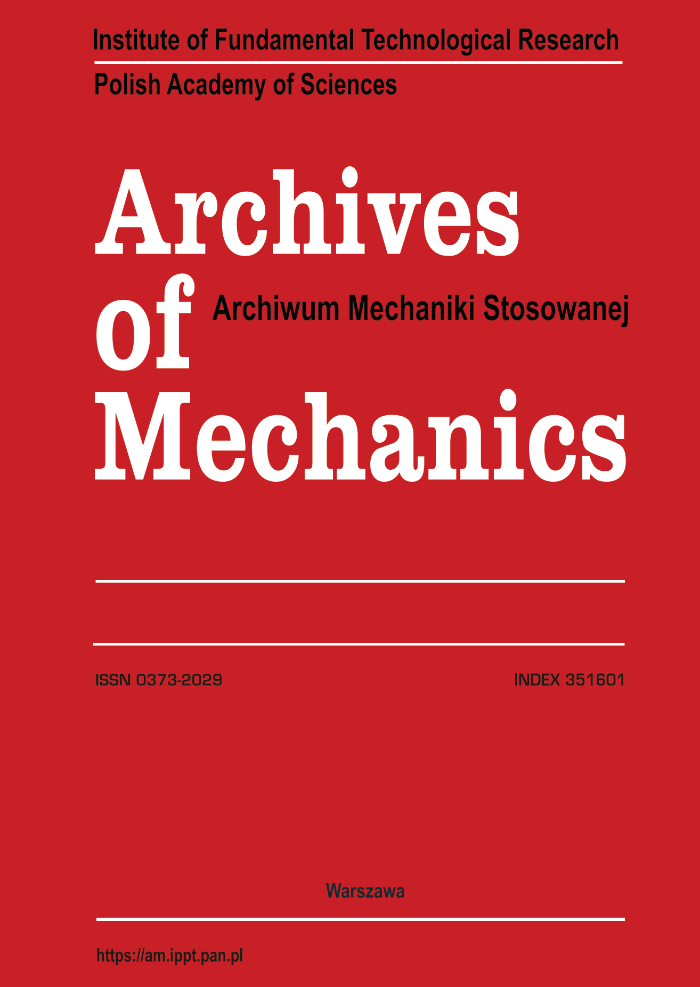Abstract
This study introduces a simplified approach to assess the buckling and static bending of advanced composite beams, including those composed of functionally graded materials (FGMs) with various porosity models. The technique utilizes a straightforward integral quasi-3D approach based on the advanced shear deformation theory. This approach offers several advantages: it simplifies the analysis by reducing the number of unknowns and equations required, improves accuracy by considering the stretch effect across the entire depth of the beam, resulting in more reliable results, and accurately represents shear by satisfying the zero-traction boundary conditions on the beam’s surfaces without the need for a shear correction factor. Additionally, it captures the parabolic pattern of transverse shear strain and stress throughout the depth of the beam. The governing equations are obtained by applying the concept of virtual work, and the Navier solution is employed to calculate analytical solutions for the buckling and static bending of FGM porous beams under different boundary conditions. The approach is in line with and builds upon existing research on FGMs and other sophisticated composite beams, further enhancing its validity and reliability. Finally, computational analyses demonstrate how the distribution of materials, such as power-law functionally graded materials (FGMs), geometry, and porosity, affect the deflections, stresses, and critical buckling load of the beam.Keywords:
higher-order shear deformation theory, FG beam, integral quasi-3D, bending, buckling, porosity, virtual work principle, Navier solutionReferences
- D. Chen, K. Gao, J. Yang, L. Zhang, Functionally graded porous structures: Analyses, performances, and applications – A review, Thin-Walled Structures, 191, 111046, 2023, https://doi.org/10.1016/j.tws.2023.111046.
- E.K. Njim, M. Al-Waily, S.H. Bakhy, A critical review of recent research of free vibration and stability of functionally graded materials of sandwich plate, IOP Conference Series: Materials Science and Engineering, 1094, 1, 012081, 2021, https://doi.org/10.1088/1757-899X/1094/1/012081.
- M. Dhuria, N. Grover, K. Goyal, Influence of porosity distribution on static and buckling responses of porous functionally graded plates, Structures, 34, 1458–1474, 2021, https://doi.org/10.1016/j.istruc.2021.08.050.
- E. Reissner, Y. Stavsky, Bending and stretching of certain types of heterogeneous aeolotropic elastic plates, Journal of Applied Mechanics, 28, 402–408, 1961, https://doi.org/10.1115/1.3641719.
- E. Arshid, A.R. Khorshidvand, Free vibration analysis of saturated porous FG circular plates integrated with piezoelectric actuators via differential quadrature method, Thin-Walled Structures, 125, 220–233, 2018, https://doi.org/10.1016/j.tws.2018.01.007.
- L. Della Croce, P. Venini, Finite elements for functionally graded Reissner–Mindlin plates, Computer Methods in Applied Mechanics and Engineering, 193, 9–11, 705–725, 2004, https://doi.org/10.1016/j.cma.2003.09.014.
- S. Trabelsi, A. Frikha, S. Zghal, F. Dammak, Thermal post-buckling analysis of functionally graded material structures using a modified FSDT, International Journal of Mechanical Sciences, 144, 74–89, 2018, https://doi.org/10.1016/j.ijmecsci.2018.05.033.
- A. Tamrabet, C. Mourad, N. Ali Alselami, A. Menasria, B. Mamen, Bouhadra, Efficient kinematic model for stability analysis of imperfect functionally graded sandwich plates with ceramic middle layer and varied boundary edges, Journal of Computational Applied Mechanics, 55, 2, 184–200, 2024, https://doi.org/10.22059/jcamech.2024.371464.947.
- F.Y. Genao, J. Kim, K.K. Żur, Nonlinear finite element analysis of temperature-dependent functionally graded porous micro-plates under thermal and mechanical loads, Composite Structures, 256, 112931, 2021, https://doi.org/10.1016/j.compstruct.2020.112931.
- M.W. Zaitoun, A. Chikh, A. Tounsi, M.A. Al-Osta, A. Sharif, S.U. Al-Dulaijan, M.M. Al-Zahrani, Influence of the visco-Pasternak foundation parameters on the buckling behavior of a sandwich functional graded ceramic–metal plate in a hygrothermal environment, Thin-Walled Structures, 170, 108549, 2022, https://doi.org/10.1016/j.tws.2021.108549.
- E. Carrera, Theories and finite elements for multilayered, anisotropic, composite plates and shells, Archives of Computational Methods in Engineering, 9, 87–140, 2002, https://doi.org/10.1007/BF02736649.
- E. Carrera, G. Giunta, P. Nali, M. Petrolo, Refined beam elements with arbitrary cross-section geometries, Computers & Structures, 88, 5–6, 283–293, 2010, https://doi.org/10.22059/jcamech.2024.371464.94710.1016/j.compstruc.2009.11.002.
- M. Arefi, M. Kiani, A.M. Zenkour, Size-dependent free vibration analysis of a three-layered exponentially graded nano-/micro-plate with piezomagnetic face sheets resting on Pasternak’s foundation via MCST, Journal of Sandwich Structures & Materials, 22, 1, 55–86, 2020, https://doi.org/10.1177/1099636217734279.
- W.-Y. Jung, W.-T. Park, S.-C. Han, Bending and vibration analysis of S-FGM microplates embedded in Pasternak elastic medium using the modified couple stress theory, International Journal of Mechanical Sciences, 87, 150–162, 2014, https://doi.org/10.1016/j.ijmecsci.2014.05.025.
- A. Soleimani, F. Zamani, H. Haghshenas Gorgani, Buckling analysis of three-dimensional functionally graded Euler–Bernoulli nanobeams based on the nonlocal strain gradient theory, Journal of Computational Applied Mechanics, 53, 1, 24–40, 2022, https://doi.org/10.22059/jcamech.2022.338327.689.
- A. Menasria, A. Tamrabet, A. Bouhadra, S. Refrafi, N.A. Alselami, B. Mamen, A. Tounsi, Nonlinear temperature dependent and visco-elastic foundation effects on the free vibration of functionally graded sandwich plates with ceramic foam core, The Journal of Strain Analysis for Engineering Design, 59, 8, 542–558, 2024, https://doi.org/10.1177/03093247241273834.
- N. Himeur, B. Mamen, S. Benguediab, A. Bouhadra, A. Menasria, B. Bouchouicha, F. Bourada, M. Benguediab, Coupled effect of variable Winkler–Pasternak foundations on bending behavior of FG plates exposed to several types of loading, Steel and Composite Structures, An International Journal, 44, 3, 353–369, 2022, https://doi.org/10.12989/scs.2022.44.3.353.
- H. Belarbi, B. Boucham, F. Bourada, A. Kaci, M. Bourada, A.J.P.M. Tounsi, Investigation on thermomechanical bending of functionally graded sandwich plates using a novel combined 2D integral plate model, Physical Mesomechanics, 27, 4, 472–484, 2024, https://doi.org/10.1134/S1029959924040118.
- A. Berkia, S. Benguediab, A. Menasria, A. Bouhadra, F.B.B. Mamen, Tounsi, K.H. Benrahou, M. Benguediab, M. Hussain, Static buckling analysis of bi-directional functionally graded sandwich (BFGSW) beams with two different boundary conditions, Steel and Composite Structures, 44, 4, 503, 2022, https://doi.org/10.12989/scs.2022.44.4.503.
- S. Al-Houri, M.A. Al-Osta, F. Bourada, Q. Gawah, A. Tounsi, S. Al-Dulaijan, Analysis of porosity-dependent wave propagation in fg-cntrc beams utilizing an integral higher-order shear deformation theory, International Journal of Structural Stability Dynamics, 25, 1, 2550233, 2024, https://doi.org/10.1142/S0219455425502335.
- M.H. Ghazwani, A. Alnujaie, H. Youzera, S.A. Meftah, A. Tounsi, Nonlinear forced vibration investigation of the sandwich porous FGM beams with viscoelastic core layer, Acta Mechanica, 235, 2889–2904, 2024, https://doi.org/10.1007/s00707-024-03865-7.
- R. Slimani, A. Menasria, M. Ali Rachedi, C. Mourad, S. Refrafi, A.A. Nimer, Bouhadra, B. Mamen, A novel quasi-3D refined HSDT for static bending analysis of porous functionally graded Plates, Journal of Computational Applied Mechanics, 55, 3, 519–537, 2024, https://doi.org/10.22059/jcamech.2024.372417.968.
- A. Tamrabet, B. Mamen, A. Menasria, A. Bouhadra, A. Tounsi, M.H. Ghazwani, A. Alnujaie, S.R. Mahmoud, Buckling behaviors of FG porous sandwich plates with metallic foam cores resting on elastic foundation, Structural Engineering and Mechanics, 85, 3, 289–304, 2023, https://doi.org/10.12989/sem.2023.85.3.289.
- R. Patil, S. Joladarashi, R. Kadoli, Effect of porosity and viscoelastic boundary conditions on FG sandwich beams in thermal environment: Buckling and vibration studies, Structures, 56, 105001, 2023, https://doi.org/10.1016/j.istruc.2023.105001.
- P.V. Avhad, A.S. Sayyad, On the static deformation of FG sandwich beams curved in elevation using a new higher order beam theory, SĀDHANĀ Academy Proceedings in Engineering Sciences, 45, 1, 188, 2020, https://doi.org/10.1007/s12046-020-01425-y.
- A.S. Sayyad, Y.M. Ghugal, Analytical solutions for bending, buckling, and vibration analyses of exponential functionally graded higher order beams, Asian Journal of Civil Engineering, 19, 607–623, 2018, https://doi.org/10.1007/s42107-018-0046-z.
- S.P. Timoshenko, On the correction for shear of the differential equation for transverse vibrations of prismatic bars, The London, Edinburgh, and Dublin Philosophical Magazine and Journal of Science, 41, 245, 744–746, 1921, https://doi.org/10.1080/14786442108636264.
- J.N. Reddy, A simple higher-order theory for laminated composite plates, Journal of Applied Mechanics, 51, 4, 745–752, 1984, https://doi.org/https://doi.org/10.1115/1.3167719.
- J. Bernoulli, Curvatura laminae elasticae, Acta Eruditorum Lipsiae, 34, 262–270, 1694.
- S.-R. Li, R.C. Batra, Relations between buckling loads of functionally graded Timoshenko and homogeneous Euler–Bernoulli beams, Composite Structures, 95, 5–9, 2013, https://doi.org/10.1016/j.compstruct.2012.07.027.
- T.-K. Nguyen, T.P. Vo, H.-T. Thai, Static and free vibration of axially loaded functionally graded beams based on the first-order shear deformation theory, Composites Part B: Engineering, 55, 147–157, 2013, https://doi.org/10.1016/j.compositesb.2013.06.011.
- T.P. Vo, H.-T. Thai, T.-K. Nguyen, A. Maheri, J. Lee, Finite element model for vibration and buckling of functionally graded sandwich beams based on a refined shear deformation theory, Engineering Structures, 64, 12–22, 2014, https://doi.org/10.1016/j.engstruct.2014.01.029.
- V. Kahya, M. Turan, Finite element model for vibration and buckling of functionally graded beams based on the first-order shear deformation theory, Composites Part B: Engineering, 109, 108–115, 2017, https://doi.org/10.1016/j.compositesb.2016.10.039.







